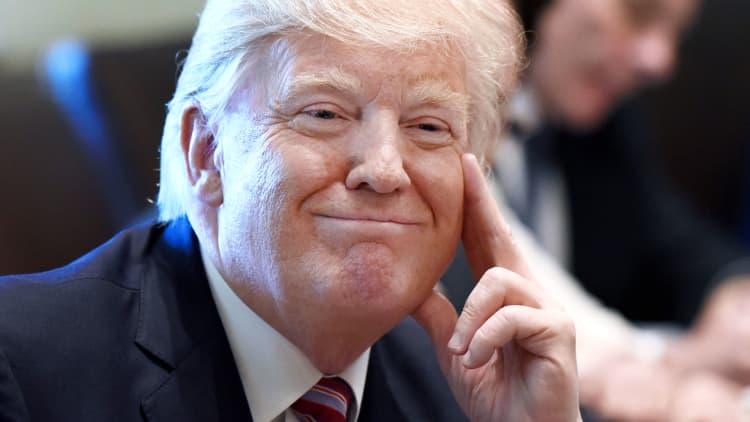
President Donald Trump inserted himself into the stock market rally this morning when he tweeted, "Business is looking better than ever with business enthusiasm at record levels. Stock Market at an all-time high. That doesn't just happen!"
Can the President claim credit for the rally? Partly. The S&P 500 did rally about 6 percent in the month after the election, clearly on hopes that Trump would bring in tax cuts, regulatory reform, and more infrastructure spending. But it has rallied an additional 10 percent this year.
Some sectors saw notable gains. Bank stocks rallied almost 30 percent in the month following the election, clearly on hopes of regulatory relief. The main bank ETF is today exactly at the level it hit in mid-December last year after that 30 percent rally — in other words, banks as a group have gone nowhere this year. You can't blame them: hopes for a rise in short-term rates have been mostly dashed, and loan growth has been modest at best. Regulatory relief is obviously a powerful inducement for owners of bank stocks.
Infrastructure spending and regulatory relief also clearly played a role lifting industrial stocks post-election, but many stocks that posted big gains — engineering companies like Flir Systems, AECOMM, and Fluor — have all faded as the Trump agenda has faded. The Industrial sector of the S&P 500 rose roughly 9 percent in the month after the election, but is up another 9 percent since then because the global economy has improved.
Technology had almost no reaction after the rally, up about 3 percent, but has been on fire this year, up 28 percent. Why? because a relatively small group of tech stocks are putting up very large earnings and revenue numbers.
And that really is the story for 2017: the S&P is up 10 percent, but the Trump agenda — aside from some modest changes in regulations — still hasn't been enacted and still seems far away.
For the most part, stocks trade off of future earnings prospects, and the rally this year is due to the improvement in the global economy and the corresponding rise in corporate earnings.
Earnings for the 500 companies in the S&P 500 are expected to be up 11 percent for the second quarter after rising 15 percent in the first quarter.
Much of this is on global growth. On Wednesday, the Dow crossed 22,000 for the first time. The 1,000 point move that occurred this year when the Dow moved from 21,000 (March) to 22,000 was due to gains from five stocks:
Dow 21,000 to 22,000: who led?
(points)
Boeing 386
McDonald's 176
UnitedHealth 169
Apple 134
Caterpillar 101
25 others 35
As UBS' Art Cashin has pointed out, four of those five stocks get more than 50 percent of their revenue outside the U.S. (UnitedHealth is the exception).
Here's the main issue: how much of a risk premium is embedded in the market for the Trump agenda of fewer regulations, tax cuts, and infrastructure.? If Trump tweeted tomorrow, "Tax cuts, infrastructure spending, and a big cut in regulations are dead. Not happening!," how much would the stock market drop?
It's not clear, but no one I speak with doubts there would be a drop. Perhaps 5 percent. Perhaps more. Clearly more in banks!


